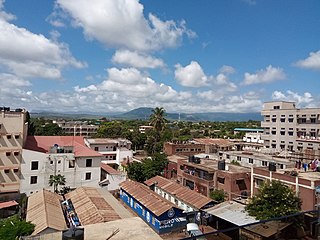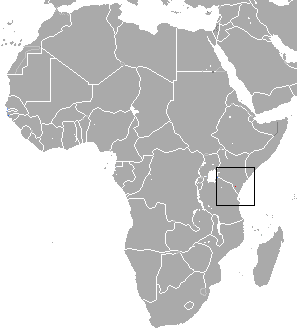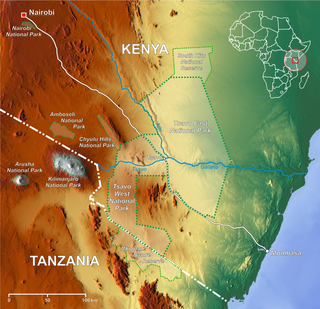
The Coast Province was one of Kenya's eight provinces. It contained all of the country's coastline on the Indian Ocean. Its capital city was Mombasa. It was inhabited by the Mijikenda and Swahili peoples, among others. The province covered an area of 79,686.1 km2.

Kericho is the biggest town in Kericho County located in the highlands west of the Kenyan Rift Valley. Standing on the edge of the Mau Forest, Kericho has a warm and temperate climate making it an ideal location for agriculture and in particular, the large scale cultivation of tea.

Voi is the largest town in Taita-Taveta County in southern Kenya, in the former Coast Province. It lies at the western edge of the Taru Desert, south and west of the Tsavo East National Park. The Sagala Hills are to the south.

Taveta is the name of a tribe found in Kenya. It is also the name of the principal town in the land of the Taveta people and the name of the surrounding subdistrict of Kenya.

The Anglican Church of Kenya (ACK) is a province of the Anglican Communion, and it is composed by 41 dioceses. The current Leader and Archbishop of Kenya is Jackson Ole Sapit. The Anglican Church of Kenya claims 5 million total members. According to a study published in the Journal of Anglican Studies and by Cambridge University Press, the ACK claims 5 million adherents, with no official definition of membership, with nearly 2 million officially affiliated members, and 310,000 active baptised members. The church became part of the Province of East Africa in 1960, but Kenya and Tanzania were divided into separate provinces in 1970.

The Taita Hills, sometimes also spelled as Teita Hills, are a mountain range located in the Taita-Taveta County in south-eastern Kenya. The hills consist of three massifs: Dawida, Sagalla in the southern side of Voi township and Kasigau in the south near the border of Tanzania. The Dawida massif is the largest and tallest of the three, with an altitude of 2,228 metres (7,310 ft) above sea level at its highest peak, Vuria. Dawida has three other main peaks: Iyale, Wesu, and Susu.

Taita–Taveta County previously known as Taita Taveta District is a county of Kenya. It lies approximately 200 km northwest of Mombasa and 360 km southeast of Nairobi.Taita-Taveta County is located approximately 360 km southeast of Nairobi and 200 km northwest of Mombasa and is a port and major gateway to the United Republic of Tanzania through Taveta town. The County headquarters are located in Mwatate sub-county, which is one of the six counties in the Jumuiya ya Kaunti za Pwani regional economic bloc. Major towns include Voi, Taveta, Mwatate and Wundanyi

Kitui County is a county in the former Eastern Province of Kenya with its capital and largest town being Kitui, although Mwingi is also another major urban centre. The county has a population of 1,136,187. and an area of 30,496 km2. It lies between latitudes 0°10 South and 3°0 South and longitudes 37°50 East and 39°0 East.
Bura is a town in Taita-Taveta County, Kenya.

Boulengerula niedeni, the Sagalla caecilian, is a worm-like amphibian first described in 2005. The species was described from a specimen discovered on Sagala Hill, an isolated mountain block of the Taita Hills in Kenya, and is not known from other areas.

The Taita people are an ethnic group in Kenya's Taita-Taveta County. They speak Kidawida or Kitaita, which belongs to the Bantu language family. The West-Bantu migrated to the Taita-Taveta County around 1000-1300.

Lake Jipe is an inter-territorial lake straddling the borders of Kenya and Tanzania. On the Kenyan side, it is located south of the village of Nghonji while on the Tanzanian side, it is situated within Mwanga District, in Kilimanjaro Region. The lake is fed mainly by the Lumi River, which descends from Mount Kilimanjaro, as well as streams from the North Pare Mountains, being on the leeward side. The lake's outlet forms the Ruvu River. Kenya's unfenced Tsavo West National Park protects part of the lake's northern shore, while on the Tanzania side Mkomazi Game Reserve is nearby. The lake is known for its endemic fish, as well as water birds, mammals, wetland plants and lake-edge swamps, which can extend 2 kilometres (1.2 mi) from Jipe's shore.
Taita is a Bantu language spoken in the Taita Hills of Kenya. It is closely related to the Chaga languages of Kenya and Tanzania. The Saghala variety is distinct enough to be considered a language separate from the Daw'ida and Kasigau dialects.

The First World War centenary was the centenary of the First World War, which began on 28 July 2014 with a series of commemorations of the outbreak of the war organised across the continent of Europe, and ended on 11 November 2018 with global commemorations of the centenary of the 1918 Armistice.

The Taita shrew is an extant species of white-toothed shrew from two localities in the Taita Hills mountain range in the Taita-Taveta District of southwestern Kenya. Given the continuing decline in the quality of this habitat, and the limitations in its range, the IUCN recognises the shrew as an endangered species.
The Rabai Museum is a museum located in Kenya. The museum is located in the first Christian church building constructed in Kenya. Much of the museum focuses on the work of Johann Ludwig Krapf, who built the church with Johannes Rebmann. The museum is housed in one of the first churches built in Kenya.
Taita-Taveta District was a district of Kenya, located in the Coast Province of that country. It lies approximately 200 km northwest of Mombasa and 360 km southeast of Nairobi city.

The Tsavo Trust is a non-profit wildlife conservation organisation, which covers Tsavo East National Park, Tsavo West National Park, and Chyulu Hills National Park in Kenya. The trust was founded by Nzioki Wa Makau and Richard Moller who is chief executive officer and an experienced bush pilot. The started aim of the trust is the protection of wildlife, especially African elephants, and the reduction of the ivory trade. In June 2014, the Tsavo Trust came into the international spotlight when it announced the death of Kenya's iconic and most well-known elephant, Satao, killed by an ivory poacher with a poisoned arrow.
The Anglican dioceses of Mombasa are the Anglican presence in and around Mombasa and south-east Kenya; they are part of the Anglican Church of Kenya. The remaining dioceses of the Church are in the areas of Maseno, of Mount Kenya, and of Nakuru.
Granton Graham Samboja is a Kenyan politician and media executive who served as the second governor of Taita Taveta County from 2017 to 2022. He is a member of the Jubilee Party of Kenya. Samboja capitalized on his background in the media and his links with President Uhuru Kenyatta to get into politics. His education background remains the subject of controversy.















